
William Morris (born 1957) [1] is an American glass artist. [2] After retiring in 2007 at the age of 49, he resides in both Washington and Hawaii.

William Morris (born 1957) [1] is an American glass artist. [2] After retiring in 2007 at the age of 49, he resides in both Washington and Hawaii.
William Morris was born on July 25, 1957 in Carmel, California, United States. [1] Morris grew up in Carmel, California. He was educated at California State University, Chico, California, [3] and Central Washington University, Ellensburg, Washington. [4]
William Morris was first introduced to glass at Pilchuck Glass School, Stanwood, Washington, [3] where he was employed as a bus driver. Early in his career (late 1970s to early 1980s) he was head gaffer for Dale Chihuly. He began making his own work in the 1980s. He relied on the same core team of assistants throughout his career; Karen Willenbrink-Johnsen, Jon Ormbrek, and Randy Walker. Some of the other artists who have worked with his team throughout the years include Blaise Campbell, Ross Richmond, and Trumaine Mason. With the help of Pino Signoretto, an Italian glass maestro from Murano, Morris developed new techniques that used oxy/propane torches to spot heat specific sections of a piece allowing for the high level of detail that his work is known for. Morris and his team maintained the William Morris Studio, WA, throughout its duration.
Morris' work is an attempt to add to the archeological record of humankind. Instead of focusing on glass's natural beauty, he uses the medium's ability to transform into wood, bone, fiber, and sinew. He is inspired by ancient civilizations, such as Egyptian, Asian, Native American and Latin American. He also draws inspiration from the wilderness and the relationship between man and animal.
Morris achieved much success during his career and retired in 2007.
Later in life while working as a glass artist, he resided in Washington. During breaks from glass making, he spent time in Idaho's Bitterroot Mountains and Pioneer Mountains and Oregon's Wallowa Mountains and Elkhorn Mountains.
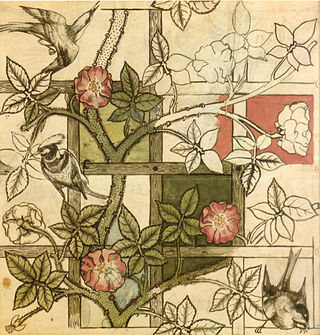
The Arts and Crafts movement was an international trend in the decorative and fine arts that developed earliest and most fully in the British Isles and subsequently spread across the British Empire and to the rest of Europe and America.

Art colonies are organic congregations of artists in towns, villages and rural areas, who are often drawn to areas of natural beauty, the prior existence of other artists, art schools there, or a lower cost of living. They are typically mission-driven planned communities, which administer a formal process for awarding artist residencies. A typical mission might include providing artists with the time, space, and support to create, fostering community among artists, and providing arts education, including lectures and workshops.

Peter Voulkos was an American artist of Greek descent. He is known for his abstract expressionist ceramic sculptures, which crossed the traditional divide between ceramic crafts and fine art. He established the ceramics department at the Los Angeles County Art Institute and at UC Berkeley.

The Chazen Museum of Art is an art museum located at the University of Wisconsin–Madison in Madison, Wisconsin. The Chazen Museum of Art is accredited by the American Alliance of Museums.
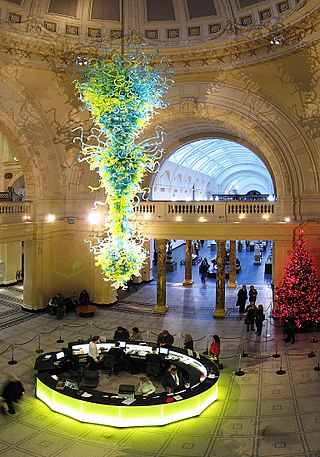
American craft is craft work produced by independent studio artists working with traditional craft materials and processes. Examples include wood, glass, clay (ceramics), textiles, and metal (metalworking). Studio craft works tend to either serve or allude to a functional or utilitarian purpose, although they are just as often handled and exhibited in ways similar to visual art objects.
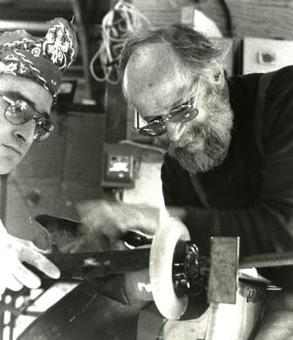
Harvey Littleton was an American glass artist and educator, one of the founders of the studio glass movement; he is often referred to as the "Father of the Studio Glass Movement". Born in Corning, New York, he grew up in the shadow of Corning Glass Works, where his father headed Research and Development during the 1930s. Expected by his father to enter the field of physics, Littleton instead chose a career in art, gaining recognition first as a ceramist and later as a glassblower and sculptor in glass. In the latter capacity he was very influential, organizing the first glassblowing seminar aimed at the studio artist in 1962, on the grounds of the Toledo Museum of Art. Imbued with the prevailing view at the time that glassblowing could only be done on the factory floor, separated from the designer at his desk, Littleton aimed to put it within the reach of the individual studio artist.

The Museum of Arts and Design (MAD), based in Manhattan, New York City, collects, displays, and interprets objects that document contemporary and historic innovation in craft, art, and design. In its exhibitions and educational programs, the museum celebrates the creative process through which materials are crafted into works that enhance contemporary life.
Marvin Bentley Lipofsky was an American glass artist. He was one of the six students that Studio Glass founder Harvey Littleton instructed in a program at the University of Wisconsin-Madison in fall 1962 and spring 1963. He was a central figure in the dissemination of the American Studio Glass Movement, introducing it to California through his tenure as an instructor at the University of California, Berkeley and the California College of Arts and Crafts.

Richard "Dick" Marquis is an American studio glass artist. One of the first Americans ever to work in a Venetian glass factory, he became a master of Venetian cane and murrine techniques. He is considered a pioneer of American contemporary glass art, and is noted for his quirky, playful work that incorporates flawless technique and underlying seriousness about form and color.
Preston Singletary is a Native American glass artist.

Dan Owen Dailey is an American artist and educator, known for his sculpture. With the support of a team of artists and crafts people, he creates sculptures and functional objects in glass and metal. He has taught at many glass programs and is professor emeritus at the Massachusetts College of Art, where he founded the glass program.
Therman Statom is an American Studio Glass artist whose primary medium is sheet glass. He cuts, paints, and assembles the glass - adding found glass objects along the way – to create three-dimensional sculptures. Many of these works are large in scale. Statom is known for his site-specific installations in which his glass structures dwarf the visitor. Sound and projected digital imagery are also features of the environmental works.

William Seltzer Rice was an American woodblock print artist, art educator and author, associated with the Arts and Crafts movement in Northern California.
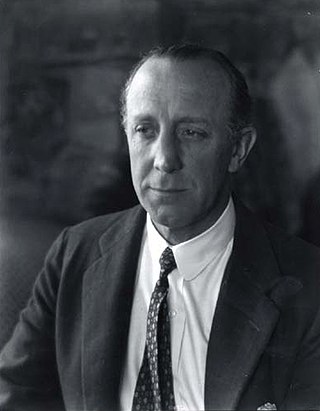
Paul Hampden Dougherty was an American marine painter. Dougherty was recognized for his American Impressionism paintings of the coasts of Maine and Cornwall in the years after the turn of the 20th century. His work has been described as bold and masculine, and he was best known for his many paintings of breakers crashing against rocky coasts and mountain landscapes. Dougherty also painted still lifes, created prints and sculpted.
Jerome A. Chazen was an American businessman who was the founder and chairman of Chazen Capital Partners. He was also one of four and last surviving founders of Liz Claiborne.

Karen LaMonte is an American artist known for her life-size sculptures in ceramic, bronze, marble, and cast glass.
Peter Mollica is an American stained glass artist.
Paul J. Smith was an arts administrator, curator, and artist based in New York. Smith was professionally involved with the art, craft, and design fields since the early 1950s and was closely associated with the twentieth-century studio craft movement in the United States. He joined the staff of the American Craftsmen's Council in 1957, and in 1963 was appointed Director of the Museum of Contemporary Crafts, a position he held for the next 25 years. In September 1987, he assumed the title of director emeritus and continued to work as an independent curator and consultant for museums, arts organizations, and collectors.
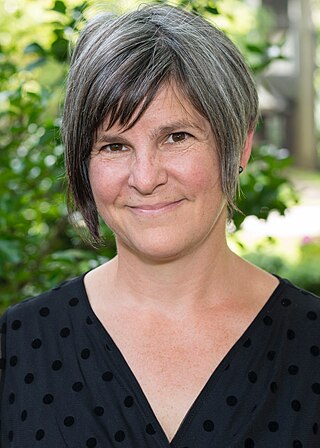
Beth Lipman is a contemporary artist working in glass. She is best known for her glass still-life compositions which reference the work of 16th- and 17th-century European painters.
Nanette L. Laitman was an art collector and philanthropist. She has been involved with the board of the Museum of Arts and Design (MAD) and its precursors in New York City for over 25 years. She became a member of the board in 1994 and board president in 2000. She was one of the main benefactors supporting MAD's relocation to 2 Columbus Circle in 2002. Laitman has also funded the Nanette Laitman Documentation Project for Craft and Decorative Arts in America at the Smithsonian's Archives of American Art.